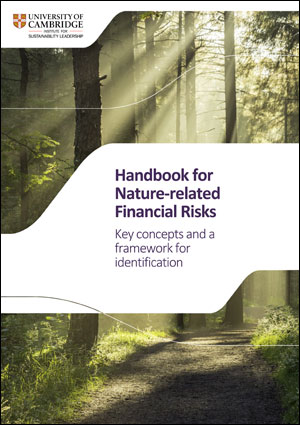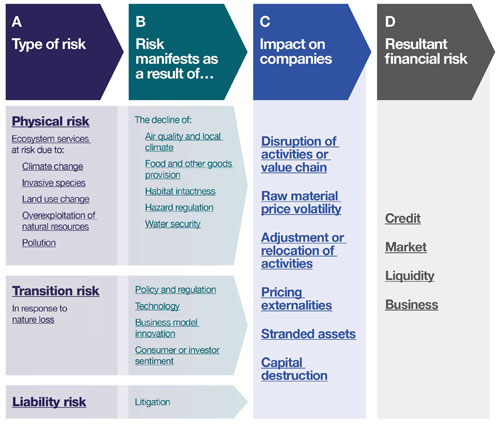1 March 2021 – The University of Cambridge Institute for Sustainability Leadership (CISL) has published a handbook for understanding and identifying nature-related financial risks.
Identifying how nature loss poses financial risks
Nature loss poses financial risks, with more than half of global GDP highly or moderately dependent on nature. Dutch financial institutions alone have around €510 billion of exposure. To support financial institutions to identify the specific nature-related financial risks they are facing we created a handbook that:
- Connects the natural and financial worlds from a risk perspective, explaining key concepts, terms and transmission channels
- Contains a framework for plotting financial risk exposures
Download the handbook and framework
October 2021 Update: Preliminary insights from Handbook use cases published
Using the Handbook for Nature-related Financial Risks, banks and investors have been assessing specific nature-related financial risks. A preview of the insights from these use cases was published in October 2021, see here.
Context
Biodiversity loss is moving up the agenda of governments, civil society and financial institutions. Billed as the ‘Year of Biodiversity’ because of the biodiversity COP in Kunming, 2020 saw biodiversity in the headlines for other reasons as a type of disease made more likely by nature loss emerged to cause a global pandemic. As efforts intensify through 2021, including the Dasgupta Review of the Economics of Biodiversity and launch of the Taskforce for Nature-related financial disclosures (TNFD), there is a growing need to increase knowledge, explain terminology and map how nature loss poses risks to financial institutions.
CISL has done exactly this, building on the Dasgupta review to produce a handbook, in collaboration with financial institutions and University of Cambridge academics, for identifying nature-related financial risks that explains key concepts and provides a framework for risk identification.
Framework for identifying nature-related financial risks
The handbook available for download contains a framework for identifying nature-related financial risks.
All the terms in the framework are defined within the handbook, such as the three sources of nature-related financial risks: physical, transition and liability. These sources of nature-related financial risks are shown in column A of the framework below.
The handbook also defines how those sources become financial risks (columns B and C) as well as providing distinctive nature-based examples for all categories, including for the resultant credit, market, liquidity and business risks that financial institutions face (column D).
Each definition is unique to how nature loss poses financial risks, but also utilises existing typologies from the Network for Greening the Financial System (NGFS) and Dutch Central Bank (DNB).
Co-created with financial institutions and University of Cambridge academics, our aim is that, by using the handbook, individuals from financial institutions can begin to identify the nature-related risks their portfolios, assets, operations and revenue streams face.
Dr Nina Seega, Research Director, Centre for Sustainable Finance, CISL said:
“Nature loss represents an unmeasured and material financial risk. Building on the Dasgupta Review of the economics of biodiversity, our handbook for nature-related financial risks provides financial institutions with the tools to take the first steps toward embedding these risks in decision making.”
Alexandra Basirov, Global Head of Sustainable Finance for Financial Institutions Coverage, BNP Paribas, said:
“This framework represents another important step forward for the financial industry to understand and identify nature-related financial risks. Mapping and translating the critical ecosystem feedback loops requires a knowledge sharing process between the science community and the financial industry. Through this collaboration between CISL and financial industry leaders, we can advance the understanding of the connections between economic activity, nature and financial risks. Looking ahead to COP26, this framework is a key tool for progressing the finance agenda to tackle the biodiversity and climate crisis.”
Carola van Lamoen, Head of Sustainable Investing at Robeco, said:
“Robeco sees the loss of biodiversity as one of the major global ecological threats expected to impact society in the coming decade. We have been, and will be very vocal on this issue to raise awareness on topics like deforestation, which has an impact on all of us. But we will also translate this into much needed concrete action, as investors struggle on how to systematically price in biodiversity risks in their portfolios. Measuring how biodiversity impacts financial assets, and the other way around is what we need to familiarize ourselves with. This publication by the University of Cambridge Institute for Sustainability Leadership is a major milestone in getting there. We are looking forward to working with the University and our peers to implement the handbook in our investment research and policy development and encourage other investors to take similar steps.”
Markus Müller, Global Head of Chief Investment Office, Deutsche Bank - International Private Bank (IPB), and Dr Alex Kusen, Investment Officer, Deutsche Bank - International Private Bank (IPB) said:
“The loss of nature poses financial risks and is of vital importance to economies, businesses, and society as more than half of global GDP is heavily or moderately dependent on nature. CISL’s Handbook for nature-related risks provides (financial) institutions with the means to engage and embed nature-related financial risks in our decision making by providing a framework for risk identification. This Handbook is a timely pathfinder, building on the Dasgupta Review of the economics of biodiversity and in anticipation of the launch of the TNFD (Taskforce for Nature-related Financial Disclosures). Deutsche Bank is excited to continue working with CISL and other financial institutions on this cornerstone subject.”
Victoria Leggett, Head of Impact Investing, UBP said:
"UBP is proud to support this guiding framework from CISL. Financial institutions are increasingly aware that the success of our economies depend entirely on the health and resilience of nature. Acting upon this awareness is not a departure from core asset-management activity – it is a fundamental part of it. In identifying the most significant types of risk we face, The CISL handbook on Nature-related financial risks supports an essential first step in the shift from awareness to action."
Next steps
This handbook is from the wider CISL programme on the nature-related financial risks.
During 2021, the financial institutions participating in this programme are using the handbook to create methodologies that assess specific cases of nature-related financial risk. These ‘use cases’ will be made public, to act as demonstrators for the wider financial industry.
Using the Handbook, CISL conducted five use cases with members of the Banking Environment Initiative and Investment Leaders Group to support further assessments by other financial institutions. These use cases quantify and assess specific nature-related financial risks, with each limited to a particular geography, risk type and sector and demonstrate the financial materiality of nature loss.
The materiality of the financial risks demonstrated also form the backbone for a new report Integrating nature: The case for action on nature-related financial risks. In this paper, CISL calls on finance leaders to act now to integrate nature into decision-making in order to manage nature-related risks and drive investment that protects and restores nature.
Citing this handbook
University of Cambridge Institute for Sustainability Leadership (CISL, 2021). Handbook for nature-related financial risks: key concepts and a framework for identification.
Authors
The authors of the handbook were Grant Rudgley and Dr Nina Seega at the CISL Centre for Sustainable Finance. They were supported at CISL by Annabel Ross, Lucy Auden and Dr Cath Tayleur.
Acknowledgements
A significant intellectual debt is owed to the work of the Network for Greening the Financial System and the De Nederlandsche Bank, as well as to Dr Anthony Waldron and Dr Matthew Agarwala from our academic review group, whose guidance and wisdom were invaluable.
The authors would also like to sincerely thank those individuals from financial institutions who supported the development of this handbook, user tested the framework and provided valuable inputs: Dr Alex Kusen (Deutsche Bank), Alexandra Basirov (BNP Paribas), Danielle Brassel (Zurich), Fiona Goulding (NatWest Group), Gaurav Ganguly (HSBC Group), Lucian Peppelenbos (Robeco), Marek Piskorz (Lloyds Banking Group), Markus Mueller (Deutsche Bank), Özgür Göker (UBP), Rhona Turnbull (NatWest Group), Rupert Welchman (UBP), Simon Connell (Standard Chartered), Tapan Datta (AON), Tim Manuel (AON), Will Wollerton (Lloyds Banking Group) Xavier Desmadryl (HSBC GAM).









